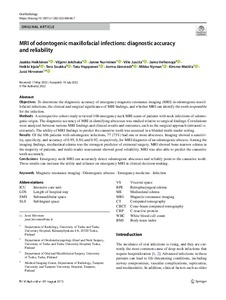MRI of odontogenic maxillofacial infections: diagnostic accuracy and reliability
Mattila Kimmo; Nurminen Janne; Heikkinen Jaakko; Happonen Tatu; Hirvonen Jussi; Jokihaka Viljami; Velhonoja Jarno; Soukka Tero; Järnstedt Jorma; Nyman Mikko; Jussila Ville; Irjala Heikki
https://urn.fi/URN:NBN:fi-fe2022102462943
Tiivistelmä
Objectives To determine the diagnostic accuracy of emergency magnetic resonance imaging (MRI) in odontogenic maxillofacial infections, the clinical and surgical significance of MRI findings, and whether MRI can identify the tooth responsible for the infection.
Methods A retrospective cohort study reviewed 106 emergency neck MRI scans of patients with neck infections of odontogenic origin. The diagnostic accuracy of MRI in identifying abscesses was studied relative to surgical findings. Correlations were analyzed between various MRI findings and clinical results and outcomes, such as the surgical approach (intraoral vs. extraoral). The ability of MRI findings to predict the causative tooth was assessed in a blinded multi-reader setting.
Results Of the 106 patients with odontogenic infections, 77 (73%) had one or more abscesses. Imaging showed a sensitivity, specificity, and accuracy of 0.95, 0.84, and 0.92, respectively, for MRI diagnosis of an odontogenic abscess. Among the imaging findings, mediastinal edema was the strongest predictor of extraoral surgery. MRI showed bone marrow edema in the majority of patients, and multi-reader assessment showed good reliability. MRI was also able to predict the causative tooth accurately.
Conclusions Emergency neck MRI can accurately detect odontogenic abscesses and reliably point to the causative tooth. These results can increase the utility and reliance on emergency MRI in clinical decision-making.
Kokoelmat
- Rinnakkaistallenteet [19206]
